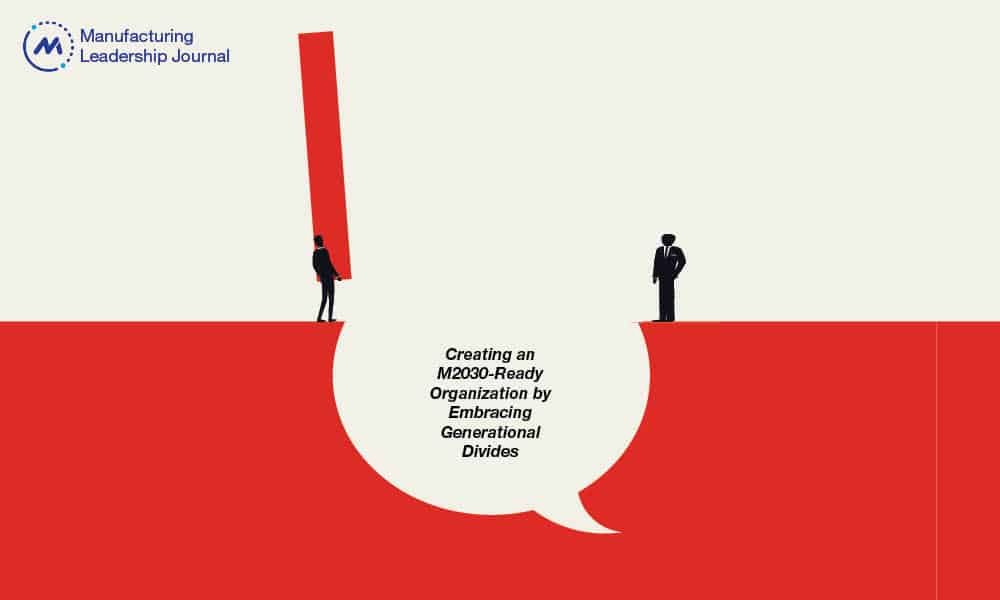Creating an M2030-Ready Organization by Embracing Generational Divides

Leveraging the strengths and understand the needs of each generation in the workforce can promote organizational resilience.

TAKEAWAYS:
● Learn how to evolve your leadership, organization, culture, and people to lead your organization to be future-fit.
● Learn how to turn the generational gap into an opportunity by leveraging the unique perspectives, skills, experiences, and preferences of each generation and fostering a culture of knowledge sharing.
● Build coaching tribes that utilize mentoring and reverse mentoring to speed up the training of your younger generations, who will soon make up the largest portion of your workforce, while leveraging the unique experience of the other generations in your workforce.
To successfully implement Manufacturing 4.0, industrial organizations must prioritize leadership, organization, culture, and people. This will enable them to build a strong foundation for adopting new technologies and processes to drive long-term growth and success.
Adopting a collaborative, cross-functional approach involving all stakeholders — employees, suppliers, and customers — requires breaking down traditional organizational silos and fostering a culture of openness, transparency, and continuous learning.
One key strategy for implementing collaborative, cross-functional structures is to establish multidisciplinary teams that bring together individuals with diverse skill sets and backgrounds. These teams should identify opportunities for improvement and develop solutions that leverage advanced technologies.
A clear vision for transformation, easy-to-understand communication of the benefits and goals of the initiative, along with training and development programs are critical change management strategies for the successful implementation of Manufacturing 4.0. Employees need the skills and knowledge to work effectively as the environment around them changes.
To ensure that the change is sustained over the long term, it’s important to use metrics to measure the success of the initiative and to continuously monitor and refine processes. Regular feedback and input from employees, customers, and other stakeholders can contribute to resiliency as market conditions change and technology advances.

“One key strategy for implementing collaborative, cross-functional structures is to establish multidisciplinary teams that bring together individuals with diverse skill sets and backgrounds.”
Creating a culture of innovation and continuous improvement can be achieved through incentivizing employees to share ideas and contribute to process improvements. Regular feedback and recognition can also encourage employees to embrace new ways of working and adopt a continuous improvement mindset.
Finally, partnerships with external stakeholders such as suppliers, customers, and industry organizations can drive innovation and collaboration within the manufacturing ecosystem, accelerating the adoption of new technologies and processes and driving overall industry growth.
Here are the lessons we’ve learned on the crucial facets to becoming a future-fit organization:
Leadership:
● Establish a clear vision and strategy for Manufacturing 4.0.
● Show top-down commitment to digital transformation and innovation.
● Communicate effectively and manage stakeholders.
● Possess strong change management skills and lead through change.
● Inspire and guide the organization through the transformation process.
● Embrace change, promote a culture of innovation, and communicate the vision and goals of Manufacturing 4.0 to all stakeholders.
Organization:
● Structure the organization to facilitate collaboration, cross-functional integration, and agile decision-making.
● Form collaborative cross-functional teams that allow for the seamless flow of information and resources.
● Implement flexible work arrangements and adopt Agile methodologies.
● Define clear roles and responsibilities to ensure accountability and alignment across teams.
● Establish robust project management processes to ensure effective execution of initiatives.
Culture:
● Cultivate a culture of innovation and continuous improvement that encourages experimentation and risk-taking.
● Emphasize data-driven decision making.
● Empower employees to make decisions and take ownership of their work.
● Promote collaboration, teamwork, and knowledge sharing.
● Develop a customer-centric culture.
● Encourage experimentation, provide tools and resources to innovate, and recognize and reward employee contributions.
People:
● Recruit individuals with the right mindset and attitude to drive innovation and change.
● Invest in training and development to ensure employees have necessary skills to operate in a digital environment.
● Promote a culture of learning and development.
● Emphasize diversity and inclusion to promote a creative and inclusive work environment.
● Recognize and reward employees who contribute to Manufacturing 4.0 initiatives’ success.
The challenge of workforce generations today
The four generations currently represented in the workforce each have unique values and expectations that shape their attitudes and behaviors in the workplace. Building organizational resilience requires understanding and leveraging the strengths of each generation.
Baby Boomers value stability and security, and many are approaching retirement age. They have a wealth of knowledge and expertise that can be leveraged through mentorship and knowledge transfer programs to build organizational resilience.
Generation X is characterized as being independent, adaptable, and tech-savvy, and they value work-life balance and career growth. To build resilience, organizations can invest in training and development programs, offer flexible work arrangements, and create career advancement opportunities.

“Organizations are shifting toward career paths that prioritize gaining experiences and skills, allowing employees to move between different parts of the organization where they can best apply them.”
Millennials are the largest generation in the workforce and are known for being entrepreneurial, collaborative, and socially conscious. They value purpose-driven work and expect a work environment that aligns with their personal values. To appeal to this group, organizations can create a purpose-driven culture, prioritize diversity and inclusion initiatives, and offer opportunities for collaboration and innovation.
Generation Z is just entering the workforce and is known for being entrepreneurial, tech-savvy, and adaptable. They value flexibility, work-life balance, and are comfortable with remote work arrangements. To build resilience, organizations can offer a flexible and technologically advanced work environment that leverages their digital skills and supports their desire for work-life balance.
To develop a framework that considers the unique characteristics and preferences of each generation, organizations can follow some key steps:
Develop a culture of respect and inclusion: Ensure that all generations are respected and valued, regardless of age or experience. Encourage communication and collaboration between generations, create a culture that embraces diversity and inclusion, and foster transparency. This improves feedback and ensures that everyone feels comfortable sharing their opinions.
Foster knowledge transfer: Develop programs that transfer knowledge and expertise from older generations to younger ones. Encourage intergenerational teams to work together on projects and initiatives through mentorship, reverse mentorship, and job shadowing opportunities.
- Provide training and development opportunities: Invest in programs that cater to the learning styles of each generation to upskill and reskill workers across all generations, using both e-learning platforms and in-person training. This will ensure that all employees have the skills needed to succeed in their current roles and in the future
- Offer flexible work arrangements: Older workers may value stability and traditional work arrangements, while younger workers may value work-life balance and flexibility. Offering flexible work arrangements such as remote work or flexible schedules can help meet the needs of all generations.

“To leverage each generation’s preferences, it’s important to identify each employee’s generation, target group within the organization, and level of training expertise.”
Leverage technology to bridge the gap between generations and facilitate communication and collaboration: Utilize social media platforms, video conferencing, and collaboration tools that allow employees to work together regardless of location or generation.
Putting it all together: Building Coaching Tribes
Today, traditional career paths are often focused on specific job titles (i.e., project manager, supply chain planner, logistic execution analyst) within functional silos. However, new organizations are shifting toward career paths that prioritize gaining experiences and skills, allowing employees to move between different parts of the organization where they can best apply them.
To leverage each generation’s preferences, it’s important to identify each employee’s generation, target group within the organization, and level of training expertise. By doing so, organizations can choose the appropriate learning methods and content to effectively train and develop their employees.
Since companies today are made up of individuals from different generations, each with their own unique skills and expectations, this diversity creates a “tribal” culture where different groups require different experiences. Therefore, we propose a reciprocal coaching environment where generations can learn from one another. More experienced members can share their seniority and knowledge, while younger members can contribute their understanding of new digital technologies and their innovative approach to work. This collaborative effort will help create a more productive and connected workplace culture. M
About the author:

Jose “Pepe” Tam is Digital Transformation Vice President at Softtek.